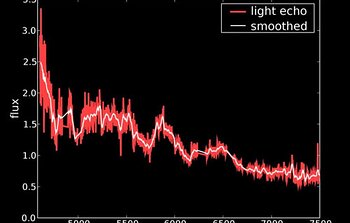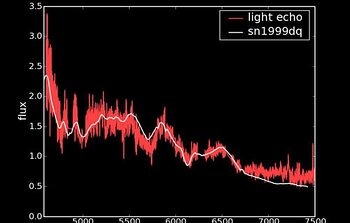Light Echoes Bring 400-year-old Supernova Into Focus
March 20, 2008

Using the powerful nod-and-shuffle technique and other sophisticated background field subtraction techniques on data from the Gemini Multi-Object Spectrograph at Gemini South, a research team led by Armin Rest (CTIO) have successfully obtained spectra from supernova light bouncing off interstellar dust. These “light echoes” have allowed astronomers to identify the type of explosion and the nature of the progenitor star which exploded in the Large Magellanic Cloud (LMC) more that 400 years ago. The GMOS spectrum is shown in Figure 1.
In a paper recently accepted in the Astrophysical Journal, Rest et al. present the results from GMOS data of SNR 0509-67.5 and confirm it as a Type Ia event. This type of supernova is the result of a solar mass white dwarf whose mass reaches a threshold limit from mass being dumped on it by an unstable companion. See Chandra X-ray Observatory press release here.
The nature of the object was first suspected from X-ray spectral abundances obtained with NASA’s Chandra X-ray Observatory and ESA’s XMM-Newton (Hughes et al. 1995 & Badenes/Bravo 2008). “This establishes the validity of this technique for studying a type of supernova that produces most of the iron in the universe,” said Rest. It is expected that this technique will be useful for other supernovae remnants now that it has been successfully demonstrated in this work.
The research was enabled by the nod-and-shuffle technique which very effectively removes sky-background from deep spectra. In addition, the dense stellar background of the LMC presented challenges that were addressed by subtracting off the stationary stellar spectral background with spectroscopy obtained one year earlier.
In addition to SNR 0509-67.5, the team have GMOS data on two other supernovae remnants in the LMC which are in stellar fields that are much denser making complete removal of the stellar spectral background impossible. These data will be presented in a future paper. We can now learn about ancient outburst that were either missed entirely or occurred prioro to the development of the spectrograph and other sensitive detectors.
SNR 0509-67.5 is located in the Large Magellanic Cloud, a small satellite galaxy to our Milky Way about 160,000 light years away. It is estimated from this data that the supernova occurred about 400 years ago (in Earth’s time frame), and was unusually bright and energetic.
Links
- “Light echoes from ancient supernovae in the Large Magellanic Cloud”, by Armin Rest et al. Nature 438, issue 7071, pp. 1132-1134, 2005.

